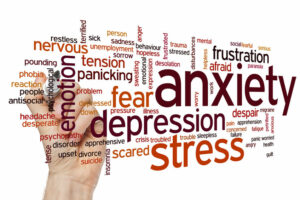We’re living in a time of anxiety, stress, and uncertainty due to the COVID-19 pandemic. All this stress puts a strain on our mental health and emotional well-being. So, my purpose, in this article, is to offer some tips for reducing your anxiety and improving the emotional health of you and your family during this unusual time. No doubt, you have some thoughts on this subject. Here are mine.
Turn down the noise
It’s a natural tendency, during a crisis, to want to consume all the news we can. It’s as though the consumption of information gives us a sense of control. It does not. Instead, it keeps the limbic system, that part of our brains that regulates our emotions, in a constant state of arousal.
Add to this the fact that media companies compete for our attention so they tend to sensationalize the news. They make everything “breaking news.” And then so many of these outlets present not just the facts but editorialize in ways that distort what is really happening, which aggravates and polarizes consumers, something that we don’t need right now.
So, shut off the constant inflow of information. I’m not suggesting that you not stay informed. Information is important. But limit the amount of time you take in information each day and make sure that you’re taking in information from authoritative and objective sources such as the World Health Organization.
Decide when you will listen or read news updates. Then turn it off for the rest of the day and you’ll feel better.
Breathe
A powerful way of dealing with our current stress is by paying more attention to our breathing. Our breath helps us
interrupt negative patterns of thought and feeling. It gives us something to focus on when we feel stressed, overwhelmed, upset, harried, or distracted. Take a moment, right now, and pay attention to your in-breath and out-breath. The more you notice your breath, the more you are able to calm yourself, even let go of, for a moment, whatever is upsetting you. Of course, thoughts will arise and your mind will wander. That is normal. Just notice the thoughts and then let your attention go back to your breath. Breathing, in this way, is like coming home. It calms your mind and centers you in your body.
Here’s a breathing technique that can help you find even greater calm. Breathe in to a count of four, hold for a count of four, breathe out for a count of four and hold at the bottom of the out-breath for the count of four. Think of it as a box with four sides—in, hold, out and hold. You can do this for just a couple of minutes to enjoy its calming benefits. And, as you become experienced, you can extend the count to 5 or 6 or 7. Although some people teach variations of this technique, this is a common form of breathing to calm and center yourself in the present.
Face your emotions
It is understandable that people want to avoid their negative emotions. And yet, have you heard the saying that “what you resist persists?” Avoiding your feelings doesn’t make them go away. They just go underground and come out in more harmful ways—such as aches and pains, or illness, or irritability, or sadness and shutting down, or even engaging in destructive, avoidance or addictive behaviors like excessive drinking, drugs, gambling, media consumption, abusing others, pornography, etc.
So, I’m asking you to take a few minutes to be alone, if possible, when you notice strong emotions coming up. Start by paying attention to your breathing for a few cycles. And then look inward, at the physical sensations and feelings in your body (rather than your thoughts). The idea is to give your feelings space, not try to get rid of them. Relax into them. Allow them. Be compassionate toward yourself for having these feelings. Notice how they begin to dissipate. You can then go back to the event of the day, knowing that you will need to repeat this process from time to time.
(Click here if you want deeper instruction in how to process your negative emotions.)
Create a worry window
You’re going to have negative thoughts during the day. You might make a mental note of them or even jot them down. Then choose a time of day to worry. Same time and place every day. Anywhere from ten to twenty minutes. Let yourself ruminate over these negative thoughts during this window of time. Then close the window, so to speak, and let go of these worries as you go back to your day. You may notice that some of the thoughts come up again, but remind yourself that you’ll worry about them during your next worry window. Lots of people find this helps them feel more relaxed, less anxious, as they go throughout the day.
Be present
Anxiety is based on uncertainty and fear of the future. One way to reduce it is to be present in the moment. As an example, I was present this morning as I ate my breakfast. Rather than rush through it, I paid attention to the taste and texture of each bite of my hot cereal. I was conscious of the bowl and spoon as well as the flower centerpiece on our kitchen table. I’d periodically glance out the window and notice the bright sky as well as tree branches swaying in a light breeze. I didn’t just see them but took them in. I listened to my wife as she read a daily thought. I really saw her, the look on her face. I heard the tone of her voice.
Being present-whether eating breakfast, doing the dishes, brushing your teeth, going for a walk or talking to someone—allows you to set aside worries about the future and also makes each moment more enjoyable. Life’s greatest pleasures are found in our moment-by-moment experience, pleasures that we miss when we’re unconscious, wishing we were somewhere else, or hurrying through life.
Make a routine
Your old routine is out the window. But it can be helpful to put a new routine and some structure in place. People, particularly children, feel a greater sense of calm, control, and emotional safety when they have a routine they can count on.
Your own routine may include getting up at a particular time, making your bed, and getting dressed (you’ll feel better than staying in your pajamas all day), and then creating a flexible schedule that includes time for what is most important to you: exercise, work, projects, family time, personal relaxation and recreation, etc. Talk to your family about your routine. Allow them to have some input. But, in the end you’ll be taking much better care of your health if you have a structure, albeit flexible, that will bring some predictability to your days.
It is also critical to have structure for the family—meals, homework or study, media and play-time, personal time, and so on. If kids are older, your family routine needs to be negotiated together. They need to have lots of input if it is going to work for them. Once in place, routines establish boundaries that help everyone know what to count on and give people space for themselves.
Connect with others
Human connection is one of our deepest needs and its particularly important to stay connected during this time when we’re isolated from so many family, friends, and coworkers.
It’s helpful to be aware of all the apps that are available to help you stay connected and choose those that will work best for you. In addition to the traditional face-to-face apps, there are specialized apps to stay in touch with neighbors, apps to watch movies together or apps to exercise together. The list of ways to stay connected goes on and on.
I want to suggest that even more important than being connected to people outside your home is maintaining really strong relationships with those inside your home. It is important to be available to these people, particularly children. Spend some one on one time with them. Be present by joining them in their world. Let them ask questions and talk about how they’re doing. Listen without judgment and give them good, age-related information about the coronavirus that will help them feel safe. Ask how you can support them.
Perhaps this is also a time to create and participate in new, meaningful rituals of connection during meal-times or mornings or evenings such as singing together, sharing gratitude statements, talking about how you’re doing, reading together, etc. I love how the Italians are staying connected by singing and talking together on their apartment balconies. What might you do in your family to support one another and yet respect boundaries and allow appropriate space?
And be aware of people who are alone, people with whom you haven’t connected in a long time, or people whom you know need special support, or those who have made a contribution to your life. Perhaps you can write a nice message of support or appreciation and send it to them or call and share it over the phone. This may be a time when you miss others and reaching out to express your love for them can provide some needed solace to someone as well as make your relationships more meaningful.
Get outdoors and into nature
We know from research that being out of doors is calming and renewing. Just twenty minutes a day out of doors helps improve vitality and emotional health. I recognize that in some states and countries people are home-bound right now. But even standing at a window and looking outdoors is healthful. And these home-bound orders are temporary. So, if possible, take time to get outside. Be present and look at your natural surroundings, like the sky. The sky is beautiful, whether overcast or sunny. It can help shift your perspective and renew your body.
Engage in spiritual practices
Many people find comfort by connecting with their higher spiritual power through prayer, journaling, meditating or reading scripture. These can be powerful moments of stillness and listening to promptings or your deeper inner wisdom. It’s most helpful if you make these practices a regular part of your daily routine.
There are many other practices, such as deep muscle relaxation, yoga, and tai chi, which integrate mind, body, and spirit and have similar calming effects. Perhaps this is a good time to learn such a practice, if you don’t already have one.
Tell yourself an empowering story
I’m not suggesting you put on a happy face and pretend everything is okay. This would be like the man who walks into his backyard that he’s neglected and is now overrun with weeds, saying, “Oh, what a beautiful garden.” We call that denial. But it is possible for this man to walk into his back yard and say, “What a mess. I’ve neglected my garden, but I love it’s potential. With sweat and toil, I can make this place lovely again.” That is an empowering story grounded in reality.
Likewise, the reality of this pandemic is not pretty. However, notice the way you’re talking to yourself about it. And then decide if there is another way you could talk to yourself. A story that is hopeful and empowering might sound like, “This virus is going to be disruptive and things are likely to get worse for a while. Frankly, I don’t know all the ways it will affect me or my family. But throughout history, life has been about dealing with hard things. I’m a resourceful person and can figure this out. I’ll manage it a week at a time. And one day it will pass and I’ll look back and realize that I met it head on, with courage and grit. I’m a stronger, more compassionate, and resilient person as a consequence of this hardship.”
Of course, these words are mine not yours. What if you came up with your own? What empowering and hopeful story could you tell yourself right now? How would your story sound? And, as you know, your story is not static but will change as circumstances change. But you’ll do better if you can learn to talk to yourself in an empowering way.
Release your creativity
This may include singing, drawing, coloring, sculpting, writing, dancing, or playing music. For some this can be a solitary activity and for others may be done in a group or with your family. Lots of people use creativity to deal with their stress. Pull out any of the art supplies you have and make them available for yourself or family members. Remember that creative expression is not about how good you are but rather the enjoyment of self-expression.
Engage in recreation and play
Another strategy to deal with stress is to engage in hobbies, recreation, and play. I’m not talking about sitting on a couch watching tv but doing things that totally engage both your mind and body. It may include playing sports in your back yard, cooking, sewing, woodworking, or even playing board games that everyone enjoys. Look for activities that are intrinsically rewarding and help you get into a state of flow meaning that you lose track of time and consciousness of self. Some of these activities may be on your own and others with family members.
Learn (and play) online
So many parents I’ve talked to felt panicked that their kids would be home from school and they would be responsible for home-schooling and keeping them busy. Of course, by now we realize that many schools are putting curriculum online to make it convenient for kids to continue learning from home. In addition, there are a ton of terrific online resources to engage and support kids in not only learning but having fun and relaxing. It’s certainly worth checking out these resources and incorporating them into your daily routine.
In addition, this may be a great time for you adults who have some extra time to learn a new language, pick up a hobby, take a deeper dive into history, gain an new job skill, or even study up on the latest science in your chosen field.
How about taking some time to search out courses of interest on such platforms as Udemy, Coursera, Skill Path, Great Courses, or YouTube? (Of course, I’m biased towards Udemy since that is where I’ve published my online courses. Plus, Udemy frequently offers courses at deeply discounted prices.) But know that you have options and this may be a great time to increase your personal learning.
Remember your strengths
One last recommendation I’ll make is to take time to remember your strengths. Consider a success from your past. It could be mastering a yoga pose, supporting a friend in a time of need, or achieving something special on the job. Think of a time when you felt on top of your game. Remember an experience in which you influenced others. Think about any experiences in which you did something hard, showed determination, or grit.
Continue coming up with such experiences and notice what they have in common. Ponder or even journal about these experiences. As you do so you’ll grow in confidence and the knowledge that you are strong. I would invite you to feel this strength in your body. Wrap your fist around these strengths as a reminder of who you are and what you are capable of doing.
Your thoughts?
So, these are some of my ideas about how to manage your fear and anxiety and take care of your emotional health as you and your loved ones go through this uncharted time. No doubt you’re doing many of them already or have come up with your own ideas that are working for you or your family. I’d love it, as would others, if you’d share what’s working for you by leaving your comment in the box below.
You don’t have to go it alone
And a final thought. There are lots of mental health resources as well as apps like Headspace, or Insight Timer that can help. And know that there are times when you don’t need to manage anxiety on your own. We all need help sometimes and it may be very appropriate to reach out to a mental health professional if your worrying and anxiety seem out of control.






Lots of ideas for lots of different kinds of people – there should be something for everyone to take advantage of here.
A mutual great friend of Roger and I passed away a few years ago. She called her worry window a “pity party”. Hers was once a week, at the exact same time and on the same day, and for exactly 20 minutes. She allowed herself to be angry at her present set of circumstances, judgmental of other people, angry, victimized by others, depressed, worried, etc., but only for 20 minutes. When the 20 minutes was up, she got up, dusted herself off, and went back to work trying to make her circumstances better. It takes practice, but it actually works very well if you stick to it!
Thanks Roger for all of your great work!
Hi Ed. Thanks for your comment. The friend you speak about was a great example of resilience. I admired her and what she taught many of us about facing life courageously.
I joined an online yoga class! Best ever.
So much wisdom and compassion in this post. Many thanks Roger, you are a ROCK for many of us. As an oldster, I was finding myself kinda glued to the news and then in a bit of a frenzy afterward. Crazy as this may sound, I…like the “sister” we share, am a organizer “freak”. I took this behavior and decided to get all my scrapbooks up to date and pitch all the junk that I had been saving. It helped my mental health to look back at all these memories over the years, organize them and remember all the good times. After all, who takes pics of bad times, right? So I am enjoying the memories of times gone by and planning some trips to make more.
Hi Pam,
What a great way to spend your time. I can see how it would help your mental health, getting organizing, decluttering (your mind as well as house), and remembering the good times. And it’ll now be easier to do that in the future. As I think about this, I’m aware of how present you have to be as you do this work. It’s by focusing on the moment and even using our hands that we find pleasure and reduce anxiety to it’s proper size.
Roger
This has been a good and excellent article. It has been helpful to me
Thanks, Gifty. I’m glad.